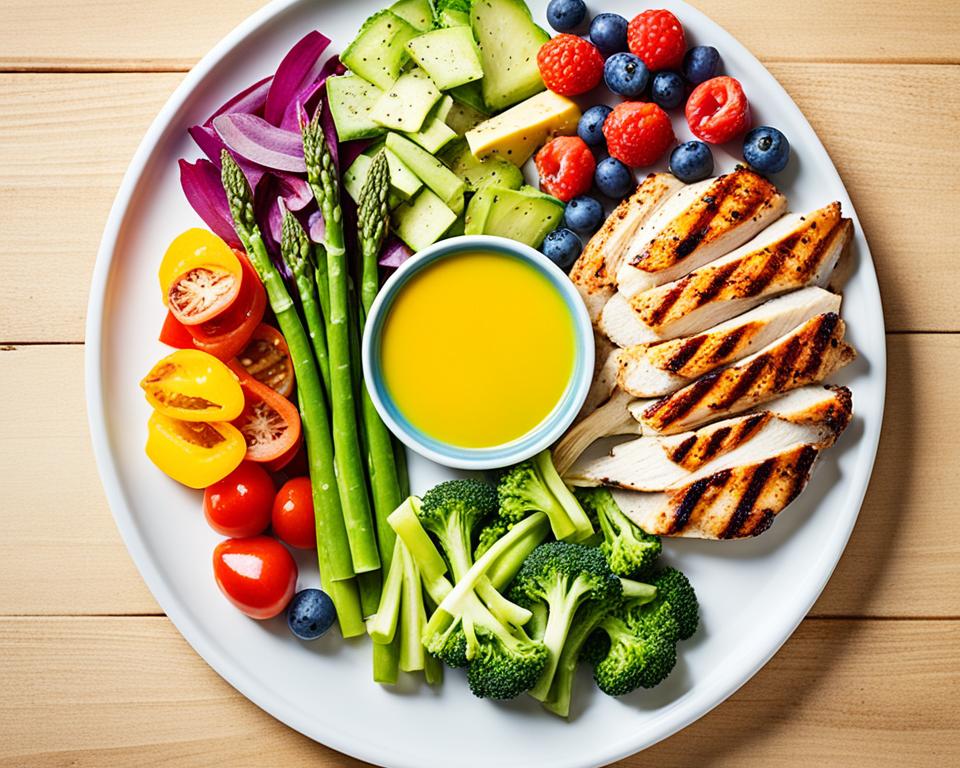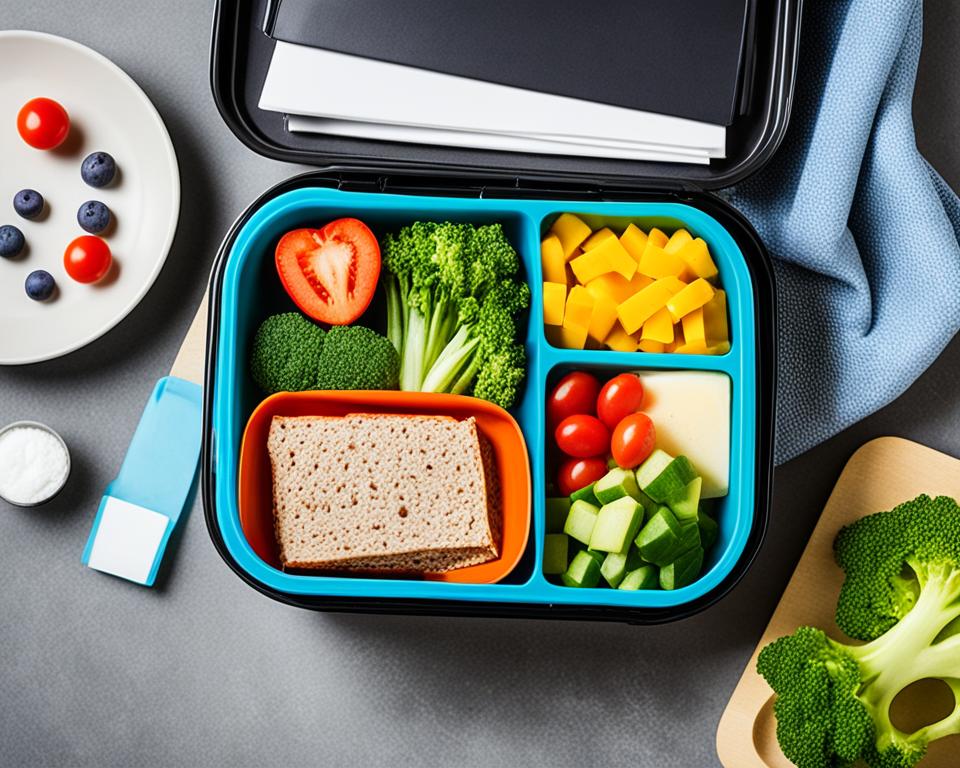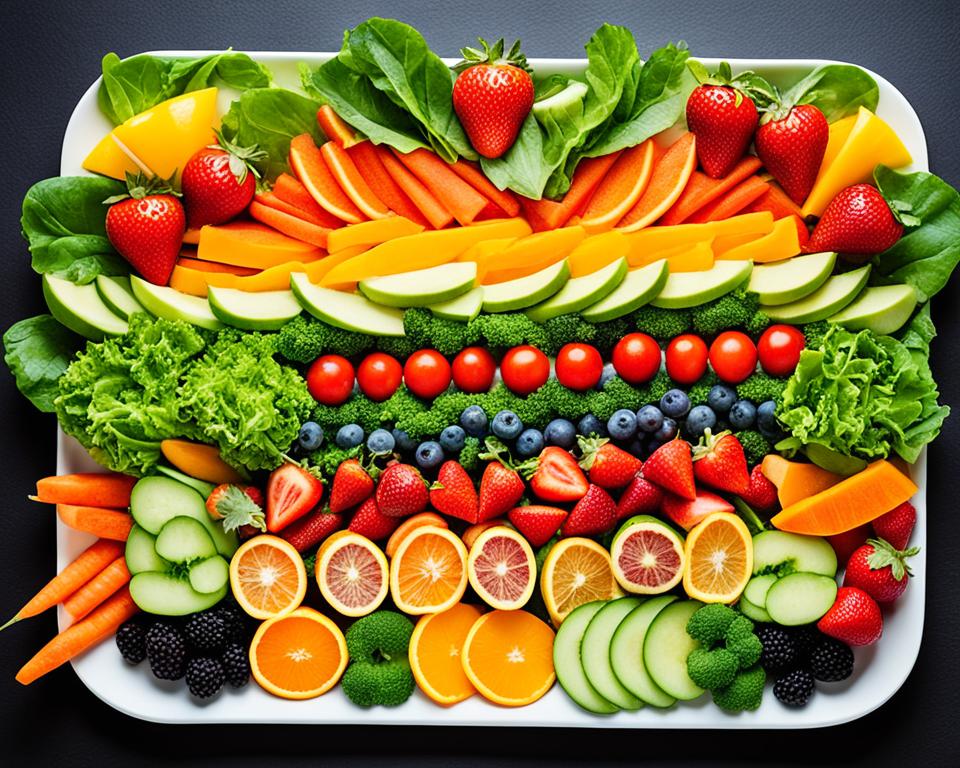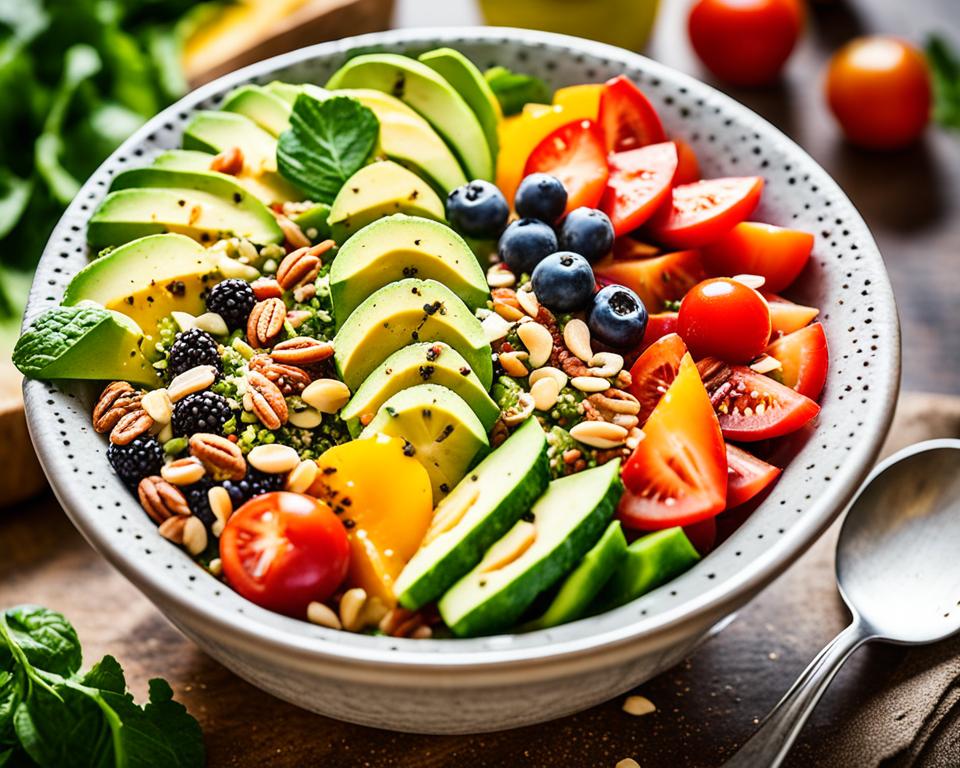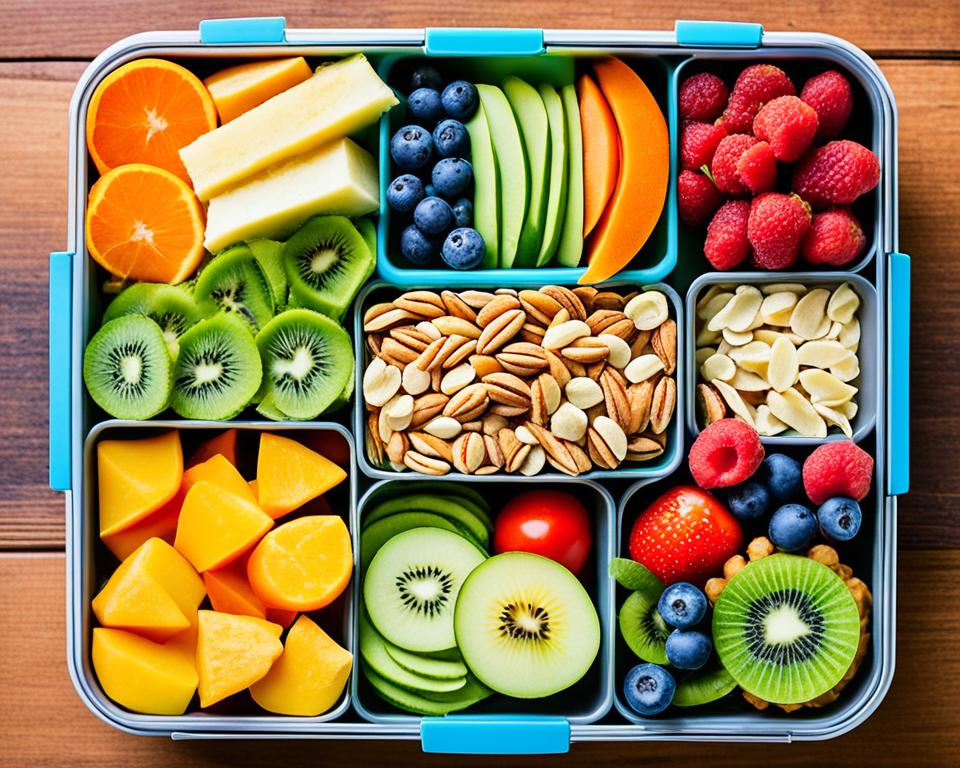Having a nutritious and satisfying lunch is essential for managing diabetes and blood sugar levels. By choosing the right foods and incorporating them into your lunchtime meals, you can control your blood sugar and stay energized throughout the day. In this article, we will provide you with a variety of healthy lunch ideas specifically designed for diabetes management.
Key Takeaways:
- Choose lunch options that are low in carbohydrates and high in fiber to help control blood sugar levels.
- Incorporate lean proteins, whole grains, nonstarchy vegetables, and healthy fats into your lunch meals.
- Plan and prepare your lunches in advance to ensure you have diabetes-friendly options readily available.
- Avoid sugary and processed foods that can spike blood sugar levels and contribute to weight gain.
- Experiment with different recipes and ingredients to keep your lunch meals interesting and enjoyable.
Green Salad With Quinoa and Low-Sugar Dressing
A green salad with quinoa and a low-sugar dressing is a simple and nutritious option for a diabetes-friendly lunch. Start with a cup of leafy greens like spinach or kale, add a variety of nonstarchy vegetables, such as carrots, tomatoes, or sweet peppers. Incorporate 2/3 cup of cooked quinoa for protein and fiber. Finish with a low-sugar dressing, like balsamic vinaigrette, to enhance the flavor without spiking blood sugar levels.
Salads are a fantastic way to incorporate nutrient-rich ingredients into your lunch and keep your blood sugar levels stable. By using a combination of leafy greens and nonstarchy vegetables, you can create a delicious and satisfying meal that is low in carbs but high in vitamins, minerals, and fiber.
Quinoa is a great choice for individuals with diabetes as it is low in glycemic index and provides a good source of protein and fiber. Including it in your salad helps promote fullness, maintain energy levels, and support healthy digestion. Additionally, quinoa contains essential nutrients such as magnesium, potassium, and folate.
When choosing a dressing for your salad, opt for low-sugar options to avoid unnecessary spikes in blood sugar levels. Balsamic vinaigrette is a popular choice as it adds tanginess and depth of flavor without compromising the health benefits of your salad.
To assemble your green salad with quinoa and low-sugar dressing, follow these steps:
- Start with a cup of washed and chopped leafy greens.
- Add a variety of nonstarchy vegetables, such as carrots, tomatoes, and sweet peppers.
- Incorporate 2/3 cup of cooked quinoa for protein and fiber.
- Finish with a drizzle of low-sugar dressing, like balsamic vinaigrette, to enhance the flavor without spiking blood sugar levels.
This salad can be enjoyed on its own for a light lunch or combined with a lean protein source, such as grilled chicken or tofu, for a more substantial meal. It is also a great option for packed lunches as it can be prepared ahead of time and stored in airtight containers.
Lean Meat and Cheese Sandwich on Whole-Grain Bread
When it comes to finding a convenient and diabetes-friendly lunch option, sandwiches are a great go-to choice. By selecting the right ingredients, you can enjoy a delicious and satisfying meal that won’t disrupt your blood sugar levels. One idea to consider is a lean meat and cheese sandwich on whole-grain bread.
To start, look for a whole-grain bread that is low in carbohydrates and high in fiber. Whole-grain options have more nutrients and a lower glycemic index, which means they won’t cause a rapid spike in blood sugar levels. This type of bread will help keep you full for longer and provide sustained energy throughout the day.
When it comes to choosing the filling, opt for lean meats such as turkey or chicken breast. These lean protein sources are low in saturated fats and will help you feel satisfied without unwanted blood sugar spikes. Add a slice of low-fat cheese for an extra protein boost.
To amp up the nutrition, include nonstarchy vegetables like lettuce and tomato. These veggies are packed with essential vitamins and minerals, plus they add a satisfying crunch to your sandwich.
Avoid condiments that are high in sugar and opt for healthier alternatives like mustard or hot sauce. These options will add flavor without the extra sugar.
This sandwich can be prepared ahead of time, making it a perfect option for those with busy lifestyles or those who prefer to bring their lunch to work. Just pack it up and take it on the go!
By making small adjustments to your sandwich ingredients, you can enjoy a delicious and diabetes-friendly lunch that fits your busy schedule.
Low-Sodium Bean Soup With a Cheese Stick and Sunflower Seeds
Bean-based soups are a delicious and filling option for a diabetes-friendly lunch. Not only are they packed with fiber and nutrients, but they also have a low glycemic index, meaning they won’t cause a rapid spike in blood sugar levels. One excellent choice is a low-sodium bean soup that provides a balance of carbohydrates, protein, and healthy fats. Pairing this soup with other nutritious ingredients can create a well-rounded and satisfying meal.
Here’s a quick and nutritious diabetic lunch recipe:
Ingredients:
- 1 cup of low-sodium bean soup
- 1 low-fat cheese stick
- 1/4 cup of unsalted sunflower seeds
Instructions:
- Heat the low-sodium bean soup on the stovetop or in the microwave until warm.
- Pair the soup with a low-fat cheese stick to add protein and calcium.
- Sprinkle a quarter cup of unsalted sunflower seeds on top for a crunchy texture and healthy fats.
Enjoy this flavorful and nutritious lunch that will leave you feeling satisfied and help manage your blood sugar levels.
| Ingredient | Amount |
|---|---|
| Low-Sodium Bean Soup | 1 cup |
| Low-Fat Cheese Stick | 1 |
| Unsalted Sunflower Seeds | 1/4 cup |

Whole-Grain Pasta With Lean Protein and Veggies
Whole-grain pasta can still be enjoyed by individuals with diabetes when paired with the right ingredients. It’s important to choose a whole-grain pasta option and limit portion sizes to keep carbohydrates in check. By adding a lean protein source such as chicken, tofu, beans, or lentils, you can enhance the nutritional value of your meal. Additionally, loading up on nonstarchy vegetables like onions, tomatoes, and wilted greens can provide essential vitamins and minerals without significantly increasing carb intake.
Benefits of Whole-Grain Pasta
Whole-grain pasta is a diabetes-friendly alternative to traditional refined pasta. Unlike refined pasta, whole-grain pasta is made from the entire grain, which provides higher fiber content. The additional fiber in whole-grain pasta helps slow down digestion and prevents blood sugar spikes. It also promotes better digestion and contributes to a feeling of fullness, making it easier to manage portion sizes.
Lean Protein Options
Including a lean protein source in your whole-grain pasta dish adds satiety and helps balance the meal. Here are some lean protein options that you can incorporate into your diabetic lunch:
- Grilled chicken breast
- Tofu
- Black beans
- Lentils
Nonstarchy Vegetables to Amp up the Flavor
Nonstarchy vegetables are an excellent choice for individuals with diabetes as they are low in carbohydrates and packed with essential nutrients. When preparing your whole-grain pasta, consider adding the following nonstarchy vegetables to enhance both flavor and nutrition:
- Onions
- Tomatoes
- Wilted greens (spinach, kale, or Swiss chard)
By incorporating these ingredients into your whole-grain pasta dish, you can create a balanced and satisfying meal that supports your diabetes management goals. Remember to control portion sizes and consult your healthcare professional or registered dietitian for personalized meal planning advice.
| Ingredient | Carbohydrates (g) | Protein (g) | Fiber (g) |
|---|---|---|---|
| Whole-Grain Pasta (1 cup cooked) | 41 | 7 | 6 |
| Grilled Chicken Breast (3 oz) | 0 | 26 | 0 |
| Tofu (1/2 cup, cubed) | 2 | 10 | 1 |
| Black Beans (1/2 cup) | 20 | 8 | 8 |
| Lentils (1/2 cup, cooked) | 20 | 9 | 8 |
| Onions (1/2 cup, chopped) | 6 | 1 | 1 |
| Tomatoes (1 medium) | 6 | 1 | 2 |
| Wilted Greens (1 cup) | 2 | 2 | 2 |
Thin-Crust Pizza With Loads of Veggies
Pizza can be a delicious and satisfying lunch option, even for those managing diabetes. By making a few smart choices, you can enjoy a thin-crust pizza packed with flavor and loaded with nutritious veggies. Opting for a whole-wheat crust reduces the carbohydrate content and provides more fiber, which helps regulate blood sugar levels.
When putting together your pizza, get creative with a variety of colorful vegetables like tomatoes, artichokes, bell peppers, and olives. These veggies not only add vibrant colors and textures to your pizza but also provide essential vitamins, minerals, and antioxidants.
Remember, portion control is key. Stick to one or two slices to ensure you’re keeping your carbohydrate intake in check and maintaining stable blood sugar levels. Pair your pizza with a side salad or some sautéed greens for added fiber and nutrients.
Benefits of Thin-Crust Pizza With Loads of Veggies
- Reduces carbohydrate content
- Provides fiber for better blood sugar control
- Delicious and satisfying meal option
- Loaded with colorful vegetables for added nutrition
| Recipe | Nutritional Information |
|---|---|
|
|
To visually stimulate your appetite, here’s an image of a mouthwatering thin-crust pizza topped with an array of vibrant vegetables:
With this delicious and diabetes-friendly pizza recipe, you can enjoy a satisfying meal while still maintaining control over your blood sugar levels. Remember to pair your pizza with a balanced plate that includes protein, vegetables, and healthy fats to create a well-rounded and nutritious lunch.
Homemade Veggie Stir-Fry With Brown Rice
Homemade vegetable stir-fry is a quick and healthy option for a diabetes-friendly lunch. Start with cooked brown rice as the base and add a variety of colorful vegetables like peppers, onions, broccoli, and carrots. Include a lean protein source like chicken, tofu, or beans for satiety. Finish with a tablespoon of low-sodium soy sauce for flavor. This meal can be prepared ahead of time and taken on the go.
| Ingredients | Instructions |
|---|---|
|
|
Tips for Success:
- Use a non-stick skillet or wok to minimize the amount of oil needed for cooking.
- Feel free to customize the stir-fry by adding your favorite vegetables or protein sources.
- For added flavor, sprinkle with sesame seeds or drizzle with sesame oil before serving.
- Prepare a large batch of stir-fry and portion it into individual containers for easy grab-and-go lunches throughout the week.
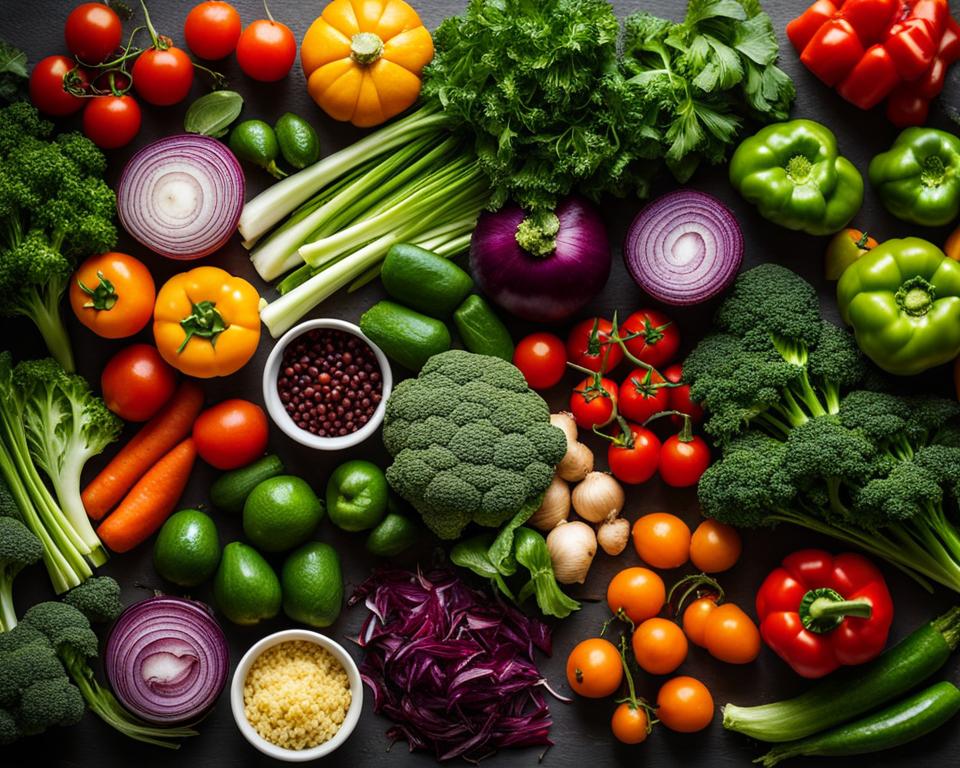
Two Hard-Boiled Eggs With Almonds and Chopped Carrots
Looking for a simple and nutritious lunch option? Try pairing hard-boiled eggs with almonds and chopped carrots. This balanced meal is satisfying, packed with nutrients, and helps control blood sugar levels in individuals with diabetes.
To prepare this meal in advance, start by hard-boiling a couple of eggs. This way, you’ll have them ready whenever you need a quick and healthy lunch. Eggs are an excellent source of protein, and they contain essential vitamins and minerals that contribute to overall health.
In addition to eggs, include a quarter cup of unsalted almonds. Almonds are rich in healthy fats, fiber, and protein. They can help regulate blood sugar levels and contribute to feelings of fullness and satisfaction.
For added fiber and vitamins, include a cup of chopped carrots. Carrots are low in carbs and have a low glycemic index, making them a diabetes-friendly option. They are also packed with essential nutrients like beta-carotene, vitamin A, and potassium.
Here’s a breakdown of the nutritional value of this lunch combination:
| Food | Calories | Carbohydrates (g) | Protein (g) | Fat (g) | Fiber (g) |
|---|---|---|---|---|---|
| Two Hard-Boiled Eggs | 140 | 1 | 13 | 10 | 0 |
| Quarter Cup of Unsalted Almonds | 206 | 7 | 8 | 18 | 4 |
| One Cup of Chopped Carrots | 52 | 12 | 1 | 0 | 3 |
This combination provides a total of approximately 398 calories, 20 grams of carbohydrates, 22 grams of protein, 28 grams of fat, and 7 grams of fiber.
Remember, balancing your meals is crucial for managing diabetes. This lunch option offers a good mix of protein, healthy fats, and fiber, which can help stabilize blood sugar levels and keep you feeling satisfied throughout the day.
Deconstructed Sushi Rolls
Looking for a healthy lunch option that satisfies your sushi cravings? Try deconstructed sushi rolls! This diabetes-friendly alternative to traditional sushi is packed with nutrients and flavor. With a few simple ingredients, you can recreate the delicious taste of sushi at home or prepare it as a meal-prep option for the week.
To make deconstructed sushi rolls, start with cooked brown rice. Brown rice is a whole grain that provides fiber and essential nutrients. It has a lower glycemic index compared to white rice, making it a better choice for managing blood sugar levels.
Top the cooked brown rice with roasted salmon or tuna. These fish options are rich in omega-3 fatty acids, which have been shown to have numerous health benefits, including reducing inflammation and supporting heart health.
Add slices of creamy avocado for healthy fats and a buttery texture. Avocado is a nutritious fruit that contains monounsaturated fats, fiber, and various vitamins and minerals.
Incorporate slices of cucumber for a refreshing crunch. Cucumbers are low in calories and high in water content, making them a hydrating addition to your lunch.
For an authentic sushi taste, include roasted seaweed. Roasted seaweed, also known as nori, is a staple in sushi preparation and adds a savory flavor to the dish.
Finish off your deconstructed sushi rolls with a tablespoon of low-sodium soy sauce. Soy sauce adds a salty and umami taste to the dish, enhancing the overall flavor experience.
This lunch option provides a balanced combination of carbohydrates, healthy fats, and proteins. It is a great way to incorporate a variety of nutrients while keeping your blood sugar levels in check.
With deconstructed sushi rolls, you can enjoy the flavors of sushi without the need for complicated rolling techniques or worrying about the carbohydrate content of sushi rice. Give this diabetes-friendly lunch option a try and satisfy your sushi cravings while maintaining a healthy eating plan.
Whole-Wheat Wrap With Lean Protein and Avocado
A whole-wheat wrap is a convenient and nutritious option for a diabetes-friendly lunch. Choose a low-carb whole-wheat tortilla or pita and spread it with a tablespoon of hummus or pesto. Add a lean protein source like turkey or chicken breast. Load up on nonstarchy vegetables like lettuce, tomatoes, cucumbers, and bell peppers. Finish with a few slices of avocado for healthy fats. This wrap can be customized to suit your personal preferences and is great for a grab-and-go lunch.
By opting for whole-wheat, low-carb options and incorporating nutritious ingredients like lean proteins, nonstarchy vegetables, and healthy fats, you can enjoy a delicious and diabetes-friendly lunch that keeps you feeling satisfied and energized throughout the day. With a little planning and creativity, lunchtime can be both enjoyable and supportive of your diabetes management goals.
| Ingredients | Instructions |
|---|---|
| – Low-carb whole-wheat tortilla or pita | 1. Lay the tortilla or pita flat on a clean surface. |
| – Hummus or pesto | 2. Spread a tablespoon of hummus or pesto evenly over the tortilla or pita. |
| – Lean protein (turkey or chicken breast) | 3. Add a few slices of lean protein, such as turkey or chicken breast. |
| – Nonstarchy vegetables (lettuce, tomatoes, cucumbers, bell peppers) | 4. Load up on nonstarchy vegetables like lettuce, tomatoes, cucumbers, and bell peppers. |
| – Avocado | 5. Finish by adding a few slices of avocado for healthy fats. |
| 6. Roll the wrap tightly and slice it in half or into smaller portions if desired. |
Enjoy this delicious and easy-to-make whole-wheat wrap as part of your diabetes-friendly lunch repertoire. It’s a versatile option that can be adapted to suit your taste preferences and nutritional needs. With its combination of whole grains, lean proteins, and healthy fats, this wrap is not only satisfying but also supports your overall diabetes management goals.
Conclusion
Managing diabetes doesn’t mean sacrificing delicious and satisfying lunches. With the right ingredients and a little planning, you can create a variety of nutritious meals that support blood sugar management. Incorporate a mix of lean proteins, whole grains, nonstarchy vegetables, and healthy fats to keep your blood sugar levels stable and your taste buds satisfied.
One key tip for diabetic lunch meal prep is to prepare your meals in advance. This not only saves time but also ensures that you have healthy lunch options readily available. Consider batch cooking proteins like grilled chicken or turkey breast to be used throughout the week. Preparing and portioning out vegetables, whole grains, and salads in advance can also make lunchtime easier.
Remember to be mindful of portion sizes and choose foods that have low glycemic index values. This means selecting whole grains over refined grains, opting for healthy fats like avocados and nuts, and incorporating plenty of fiber-rich vegetables. By making smart choices and being consistent with your meal planning, you can enjoy a delicious and diabetes-friendly lunch every day.
FAQ
What are some healthy lunch ideas for diabetes management?
Here are some diabetes-friendly lunch ideas that you can incorporate into your meal plan:
How can I make a green salad suitable for diabetes?
Start with a cup of leafy greens like spinach or kale, add a variety of nonstarchy vegetables, such as carrots, tomatoes, or sweet peppers. Incorporate 2/3 cup of cooked quinoa for protein and fiber. Finish with a low-sugar dressing, like balsamic vinaigrette, to enhance the flavor without spiking blood sugar levels.
What are some quick and nutritious lunch options for diabetes?
Bean-based soups, whole-grain pasta with lean protein and veggies, and homemade veggie stir-fry with brown rice are all great options for quick and nutritious diabetes-friendly lunches.
How can I make a diabetes-friendly sandwich?
Choose a whole-grain bread that is low in carbohydrates and high in fiber. Opt for lean meats, such as turkey or chicken breast, and add a slice of low-fat cheese. Include nonstarchy vegetables, like lettuce and tomato, for added nutrition. Avoid condiments high in sugar and opt for healthier alternatives like mustard.
Can I still enjoy pizza with diabetes?
Yes, you can! Opt for a thin-crust, whole-wheat pizza to reduce the carbohydrate content. Load up on a variety of veggies like tomatoes, artichokes, bell peppers, and olives for added flavor and nutritional value. Stick to one or two slices to keep portions in check and control blood sugar levels.
What are some diabetes-friendly lunch meal prep tips?
You can prepare whole-grain pasta with lean protein and veggies ahead of time or make a homemade veggie stir-fry with brown rice and portion it into containers for the week. These meal prep ideas will save you time and ensure you have nutritious lunches ready to go.
How can I make a balanced lunch with hard-boiled eggs?
Pair hard-boiled eggs with a quarter cup of unsalted almonds for healthy fats and protein. Include a cup of chopped carrots for added fiber and vitamins. This combination provides a balanced meal that is satisfying and helps control blood sugar levels.
Are there any alternatives to traditional sushi for diabetes?
You can make deconstructed sushi rolls by starting with cooked brown rice and topping it with roasted salmon or tuna. Add avocado, cucumber, and roasted seaweed for a burst of flavor and healthy fats. Finish with a tablespoon of low-sodium soy sauce for added taste.
How can I make a diabetes-friendly wrap?
Choose a low-carb whole-wheat tortilla or pita and spread it with a tablespoon of hummus or pesto. Add a lean protein source like turkey or chicken breast. Load up on nonstarchy vegetables like lettuce, tomatoes, cucumbers, and bell peppers. Finish with a few slices of avocado for healthy fats.
How can I enjoy a variety of nutritious lunches with diabetes?
By making smart choices like incorporating a mix of lean proteins, whole grains, nonstarchy vegetables, and healthy fats, you can enjoy a delicious and diabetes-friendly lunch every day. It’s all about balance and portion control.

